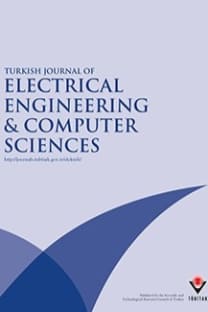Approximations of higher-order fractional differentiators and integrators using indirect discretization
Fractional order differentiators, fractional order integrators, half and one-fourth order differentiators and integrators, continued fraction expansion
Approximations of higher-order fractional differentiators and integrators using indirect discretization
Fractional order differentiators, fractional order integrators, half and one-fourth order differentiators and integrators, continued fraction expansion,
___
- Al-Alaoui MA. Al-Alaoui operator and the new transformation polynomials for discretization of analogue systems. Electr Eng 2008; 90: 455–467.
- Al-Alaoui MA. Using fractional delay to control the magnitudes and phases of integrators and differentiators. IET Signal Process 2007; 1: 107–119.
- Al-Alaoui MA. Linear phase low pass IIR digital differentiators. IEEE T Signal Proces 2007; 55: 697–706.
- Al-Alaoui MA. Al-Alaoui operator and the α -approximation for discretization of analogue systems. Facta Univer- sitatis Ser Elec Energ 2006; 19: 143–146.
- Al-Alaoui MA. Novel stable higher order s-to-z transforms. IEEE T Circuits-I 2001; 48: 1326–1329.
- Al-Alaoui MA. Novel class of digital integrators and differentiators. IEEE T Signal Proces 2009; PP: 1.
- Al-Alaoui MA. Class of digital integrators and differentiators. IET Signal Process 2011; 5: 251–260.
- Leulmi F, Ferdi Y. An improvement of the rational approximation of the fractional operator sα. SIECP Saudi International 2011; 1–6.
- Ferdi Y. Computation of fractional order derivative and integral by power series expansion and signal modeling. Nonlinear Dynam 2006; 46: 1–15.
- Das S, Majumder B, Pakhira A, Pan I, Das S, Gupta A. Optimizing continued fraction expansion based IIR realization of fractional order differ-integrators with genetic algorithm. In: International Conference on Process Automation, Control, and Computing (PACC), 2011, pp. 1–6.
- Gupta M, Jain M, Jain N. A new fractional order recursive digital integrator using continued fraction expansion. In: India International Conference on Power electronics (IICPE), 2010, pp. 1–3.
- Maione G. Rational discrete approximation to the operator s0.5. IEEE Signal Proc Let 2006; 13: 141–144.
- Barbosa RS, Machado JAT, Jesus IS. A general discretization scheme for the design of IIR fractional filters. In: Seventh International Conference on Intelligent System Design and Applications (ISDA), 2007, pp. 665–670.
- Chen YQ, Moore KL. Discretization schemes for fractional-order differentiators and integrators. IEEE T Circuits-I 2002; 49: 363–367.
- Vinagre BM, Chen YQ, Petras I. Two direct Tustin discretization methods for fractional-order differentia- tor/integrator. J Frankl Instit 2003; 340: 349–362.
- Chen YQ, Vinagre BM. A new IIR-type digital fractional order differentiator. Signal Process 2003; 83: 2359–2365.
- Chen YQ, Vinagre BM, Podlbny I. Continued fraction expansion approaches to discretizing fractional order deriva- tives – an expository review. Nonlinear Dynam 2004; 38: 155–170.
- Gupta M, Varshney P, Visweswaran GS, Kumar B. Novel digital differentiator and corresponding fractional order differentiator models. In: Proceedings of International Conference on Signal Processing and Multimedia Applications (SIGMAP), 2008, pp. 47–54.
- Varshney P, Gupta M, Visweswaran GS. Implementation of first and third order fractional order differentiators and integrators using switched capacitors. In: India International Conference on Power electronics (IICPE), 2010, pp. 1–
- Gupta M, Varshney P, Visweswaran GS. First and higher order operator based fractional order differentiator and integrator models. In: TENCON2009 IEEE Region 10 Conference, 2009, pp. 1–6.
- Gupta M, Varshney P, Visweswaran GS. Digital fractional-order differentiator and integrator models based on first-order and higher order operators. Int J Circ Theor App 2011; 39: 461–474.
- Varshney P, Gupta M, Visweswaran GS. Switched capacitor realizations of fractional-order differentiators and integrators based on an operator with improved performance. Radioengineering 2011; 20: 340–348.
- Zeng QS, Cao GY, Zhu XJ. The effect of the fractional order controller’s orders variation on the fractional order control systems. In: Proceedings of International Conference on Machine Learning and Cybernetics, Beijing, 2002, pp. 367–372.
- Krishna BT, Reddy, KVVS. Design of fractional order digital differentiators and integrators using indirect dis- cretization. International Journal for Theory and Applications 2008; 11: 143–151.
- Krishna BT, Reddy KVVS. Design of digital differentiators and integrators of order 1/2. World Journal of Modeling and Simulation 2008; 4: 182–187.
- Krishna BT. Studies of fractional order differentiators and integrators: a survey. Signal Process 2011; 91: 386–426.
- Yadav R, Gupta M. Design of fractional order differentiators and integrators using indirect discretization approach. In: IEEE International Conference on Advances in Recent Technologies in Communication and Computing, 2010, pp. 126–130.
- Yadav R, Gupta M. Design of fractional order differentiators and integrators using indirect discretization scheme. In: India International Conference on Power Electronics (IICPE), 2010, pp. 1–6.
- Upadhyay DK. Class of recursive wide band digital differentiators and integrators. Radio Engineering Journal 2012; 21: 904–910.
- Khovanskii AN. The Application of Continued Fractions and Their Generalizations to Problems in Approximation Theory. Groningen, the Netherlands: P. Noordhoff Ltd., 1963.
- ISSN: 1300-0632
- Yayın Aralığı: Yılda 6 Sayı
- Yayıncı: TÜBİTAK
Mehmet AKAR, Mahmut HEKİM, Umut ORHAN
Levent CİVCİK, Burak YILMAZ, Yüksel ÖZBAY, Ganime Dilek EMLİK
Cebrail ÇİFLİKLİ, Ahmet Turgut TUNCER, Yusuf ÖZTÜRK
Estimating facial angles using Radon transform
Mohamad Amin BAKHSHALI, Mousa SHAMSI
Predictive control of a constrained pressure and level system
ERKAN KAPLANOĞLU, TANER ARSAN, HÜSEYİN SELÇUK VAROL
BEKİR MUMYAKMAZ, KERİM KARABACAK
Fidan KAYA, Gürel YILDIZ, Adnan KAVAK
ÇİĞDEM GÜNDOĞAN TÜRKER, FERİHA ERFAN KUYUMCU, NURHAN TÜRKER TOKAN
